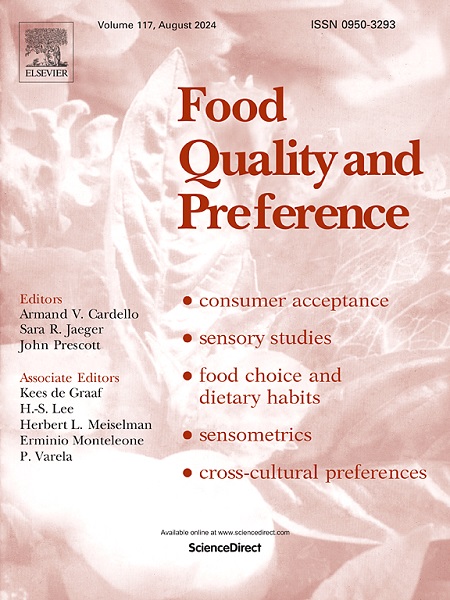Exploring consumer acceptance of grass-derived proteins in the UK: A structural equation modelling approach
IF 4.9
1区 农林科学
Q1 FOOD SCIENCE & TECHNOLOGY
引用次数: 0
Abstract
Grass-derived proteins, as a novel and sustainable source of nutrition, offer potential solutions for food security and environmental sustainability but face challenges in consumer adoption. This study investigates the factors influencing consumer acceptance and intentions to consume grass-derived proteins in the United Kingdom using a Structural Equation Modelling (SEM) approach to capture the complex relationships among psychological, social, and product-related variables. Data were collected via a cross-sectional survey of 990 participants, capturing attitudes, subjective norms, perceived behavioural control, facilitators and food neophobia. The findings reveal that facilitators such as perceived health benefits, nutritional value, and safety significantly enhance consumer willingness to adopt grass-derived ingredients. Further, negative attitudes reduce positive attitudes towards meat preferences which in turn leads to positive intentions to consume grass-derived proteins. A multigroup analysis of the meat avoiders-reducers and regular meat consumers reveals different pathways influencing their behavioural intentions. Facilitators emerge as the strongest predictors of intention for both groups, but differences in the strength of pathways underscore the need for tailored marketing and policy interventions. For avoiders-reducers, direct pathways from facilitators to intention dominate, while indirect pathways involving attitudes towards meat hold minimal influence.
Conversely, meat consumers exhibit stronger resistance tied to cultural perceptions of grass-derived products. These findings suggest emphasizing strategies to enhance consumer familiarity and address sensory concerns while leveraging the environmental and health benefits of grass-derived proteins. By addressing group-specific drivers and barriers, these efforts can foster broader acceptance of sustainable food innovations, contributing to global goals for food security and environmental sustainability.
探索消费者接受草源蛋白在英国:结构方程建模方法
草源性蛋白质作为一种新型的可持续营养来源,为食品安全和环境可持续性提供了潜在的解决方案,但在消费者采用方面却面临着挑战。本研究采用结构方程建模(SEM)方法来捕捉心理、社会和产品相关变量之间的复杂关系,调查了影响英国消费者接受和消费草源性蛋白质意愿的因素。数据是通过对 990 名参与者进行横截面调查收集的,调查内容包括态度、主观规范、感知行为控制、促进因素和食物新恐惧症。研究结果表明,促进因素(如感知到的健康益处、营养价值和安全性)能显著提高消费者采用草提取成分的意愿。此外,消极态度会降低消费者对肉类偏好的积极态度,进而导致消费草源性蛋白质的积极意愿。对避免食用肉类的消费者和经常食用肉类的消费者进行的多组分析揭示了影响他们行为意向的不同途径。对于这两个群体来说,促进因素都是预测行为意向的最有力因素,但途径强度的差异突出表明,有必要采取有针对性的营销和政策干预措施。相反,肉类消费者则表现出更强烈的抵触情绪,这与他们对草衍生产品的文化观念有关。这些研究结果表明,在利用草源性蛋白质的环境和健康益处的同时,应强调提高消费者熟悉度和解决感官问题的策略。通过解决特定群体的驱动因素和障碍,这些努力可以促进更广泛地接受可持续食品创新,为实现粮食安全和环境可持续发展的全球目标做出贡献。
本文章由计算机程序翻译,如有差异,请以英文原文为准。
求助全文
约1分钟内获得全文
求助全文
来源期刊

Food Quality and Preference
工程技术-食品科技
CiteScore
10.40
自引率
15.10%
发文量
263
审稿时长
38 days
期刊介绍:
Food Quality and Preference is a journal devoted to sensory, consumer and behavioural research in food and non-food products. It publishes original research, critical reviews, and short communications in sensory and consumer science, and sensometrics. In addition, the journal publishes special invited issues on important timely topics and from relevant conferences. These are aimed at bridging the gap between research and application, bringing together authors and readers in consumer and market research, sensory science, sensometrics and sensory evaluation, nutrition and food choice, as well as food research, product development and sensory quality assurance. Submissions to Food Quality and Preference are limited to papers that include some form of human measurement; papers that are limited to physical/chemical measures or the routine application of sensory, consumer or econometric analysis will not be considered unless they specifically make a novel scientific contribution in line with the journal''s coverage as outlined below.
 求助内容:
求助内容: 应助结果提醒方式:
应助结果提醒方式:


